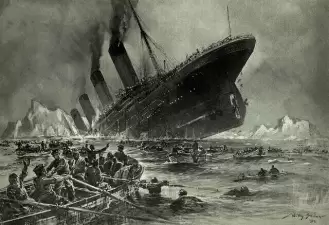
It seems to me that for the most part blogs on investing focus on the successes of the investors. Generally these blogs make investment suggestions then trumpet successes. Failures certainly seem to be under-reported. In the opposite spirit this is the story of the worst investment I ever made.
The Titanic
Maybe it’s because of the movie but most people I know have heard of the Titanic. My investment was like the titanic in two ways. First, it set out with high expectations and unfounded certainty in the safety of the vessel, only to sink like a stone. Second, it was in the titanic. I invested in the Titanic
No, I’m not wildly old. An investor in the actual Titanic at least had the justification that they were investing in a working ship. Lay-investors probably couldn’t have known that the ship was going to sink (though I’d have liked to have met the man that managed to get short on the Titanic because he thought it was going to sink). What I invested in was the Titanic artifacts, and the salvage rights on the Titanic. You see, a company named Premier Exhibitions had acquired the Titanic artifacts and the salvage rights. These are the guys that do the Bodies exhibition among other things. Someone had signed a letter of intent to buy these assets for 189 Million ($3.78 per share). That deal fell apart due to financing, and as part of it a court set some restrictions on how a potential buyer had to care for the artifacts. However, the company was profitable (barely) At this point I made my first investment when the stock was trading for $2.69 per share, I invested a relatively small amount of capital (2.5%).
The march of doom
The price proceeded to fall from $2.60 to $1.60 because a major holder had partially liquidated his holding. This by itself wasn’t terrible news, it would simply give me an opportunity to buy more of the stock at a discount. (At least that’s what I thought at the time). So I ponied up another 5% of the portfolio. In 2014 the stock fell again. This time down to about $0.85 per share. This drop was different. It was due to the fact that the company was no longer profitable and that they had taken out a loan on poor terms. The company might not survive to realize the value of the assets. I reasoned that I had not invested in the company for its earnings, so that didn’t matter to me, and that shareholders would be driven to make a sale of the titanic assets happen before the company went under. Even if they sold it at a 50% discount I would come out ahead (so I figured). I therefore invested another 7.5% of the portfolio on the way down to $0.85 per share. (Everyone keeping track, we’re up to 15%, obviously this investment was worth substantially less than that now.) The same reasoning applied the following year when the stock fell to about $0.50 per share and I invested another 5% of the portfolio. Eventually my string of errors became obvious to me and I sold, part at $0.50 per share and part at $0.22 per share. (The stock did a 10:1 reverse split so in order to compare these values with current numbers available on a finance portal you need to multiply them all by 10). By the time I exited Premier Exhibitions had fallen a gut-wrenching 92%. If you add up all of my purchases and sales I managed to lose 55% of the money I invested, this was about 10% of my portfolio.
What went wrong
The joke I liked to tell at this point was, what do you call a company that falls 90%? A company that Adam loses 80% of his money on, invests more and proceeds to lose 50% of that money. As far as I can see it there were two large mistakes here. First was that an asset is only worth the discounted values of the future cash it generates. The titanic artifacts weren’t making Premier any money, who would pay $190 million for them? Depending on other people having a irrational attachment to the artifacts was the entire basis of the investment. It didn’t work out. Second, I was excited about this investment. I was losing money on it and I liked trotting it out as an example of me doing badly in the market. I thought that this would balance me out and not get overconfident. The problem was that every time I explained my reasoning, I was just pounding this wrong idea harder into my head. So I’d explain why I thought it was a good idea even though I was losing money, then go and invest another 5% of the portfolio in it! Charlie Munger explained this in a famous speech he gave in 1995:
And of course, if you make a public disclosure of your conclusion, you’re pounding it into your own head. Many of these students that are screaming at us, you know, they aren’t convincing us, but they’re forming mental change for themselves, because what they’re shouting out [is] what they’re pounding in. And I think educational institutions that create a climate where too much of that goes on are…in a fundamental sense, they’re irresponsible institutions. It’s very important to not put your brain in chains too young by what you shout out.
I strongly advise you to read the whole speech called “the psychology of human misjudgment”, it is available here.
So what did I learn? First, diversification is really important, simply because if you are making an error it protects you. I still outperformed the market during the 2013 to 2015 period despite losing 10% of the portfolio because of diversification. Second, I should probably limit myself to only investing a certain percentage of the portfolio in a specific stock even if “better” opportunities present themselves. This might help protect me from confirmation bias in the future. Anyone else have any horror stories about buying individual stocks? I can’t be the only one out there with a massive loser.
Adam Woods is a physicist. His research interests include building software to run and build geomagnetic models. Adam got interested in personal finance in the great recession when it became obvious an interest was necessary.
After harassing his friends and family (and a short intervention) he took to the web where he blogs about finance, investment, politics, and economics.
Adam is currently located in Boulder, Colorado where he can generally be found hiking, biking, or running a D&D campaign. He can also be contacted at adamwoods137@gmail.com.

